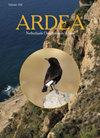大珊瑚的食物生态与水透明度的关系研究需要系统调整数据:以波兰两个水库为例
IF 1.3
4区 生物学
Q3 ORNITHOLOGY
引用次数: 1
摘要
水的透明度是影响潜水鸟类获得鱼类(水下能见度)的重要因素。6月至11月,在波兰多布切斯(Dobczyce)山区水库,通过颗粒分析,研究了大鸬鹚(Great Cormorants Phalacrocorax carbo)饮食与水透明度(范围1.4-4.0 m)的关系。虽然水的透明度被证明与鸟类的分布有关,但在研究的浊度范围内,没有发现与鱼类种类和鱼的大小有关。在14种饵料中,月均以蟑螂Rutilus Rutilus占优势(2002年35-91%,2004年56-82%)。在秋季(2011年8 - 11月和2012年)迁徙期间,研究了大鸬鹚在浑浊低地水库Goczałkowice的数量和水透明度(0.4-1.4 m)。这里的观察表明,水透明度对食物吸收和栖息地选择的影响仅在0.6 m Secchi深度以下明显。大鸬鹚觅食数量不仅受采巢深度的影响,还受年、月、地、采巢深度和水深等多种因素的影响。我们认为,特别是当大鸬鹚的数量很低时,只有高度详细的测量这些因素(空间和时间序列)才能显示猎物分布,环境条件和捕食者行为之间的复杂关系。本文章由计算机程序翻译,如有差异,请以英文原文为准。
Studies of Food Ecology of Great Cormorant Phalacrocorax carbo in Relation to Water Transparency Require System-Adjusted Data: An Example from Two Polish Reservoirs
Water transparency is an important factor affecting fish availability (underwater visibility) for diving birds. The diet of Great Cormorants Phalacrocorax carbo in relation to water transparency (range 1.4–4.0 m) was studied by pellet analyses at the submontane reservoir Dobczyce, Poland, from June to November. Although water transparency proved to be related to the birds' distribution, in the range of turbidities studied, no relationship was found with either fish species and fish size taken. Of 14 species in the diet, Roach Rutilus rutilus was dominant in all monthly samples (35–91% in 2002, 56–82% in 2004). Numbers of Great Cormorants and water transparency (range 0.4–1.4 m) were studied in the turbid lowland reservoir Goczałkowice during the migration period in autumn (August–November 2011 and 2012). Observations here suggest that the effect of water transparency on food uptake and habitat choice was only apparent below 0.6 m Secchi depth. The number of foraging Great Cormorants was not only affected by Secchi depth, but by a complex of factors (year, month, place, Secchi depth and water depth). We argue that, especially when the number of Great Cormorants is low, only highly detailed measurements of these factors (both spatially and as time series) can show the complex relationship between prey distribution, environmental conditions and the predator's behaviour.
求助全文
通过发布文献求助,成功后即可免费获取论文全文。
去求助
来源期刊

Ardea
生物-鸟类学
CiteScore
2.10
自引率
0.00%
发文量
49
审稿时长
>12 weeks
期刊介绍:
Ardea is the scientific journal of the Netherlands Ornithologists'' Union, and is published since 1912. The journal welcomes manuscripts reporting significant new findings in ornithology, in particular those covering the ecology, life history, and evolution of birds, and including sound descriptive work. Ardea publishes Original research papers, Short notes and Book reviews. In addition to the regular three issues per year, Ardea publishes specials that contain conference or workshop proceedings (produced on request).
 求助内容:
求助内容: 应助结果提醒方式:
应助结果提醒方式:


